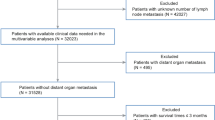Abstract
Background
The threshold and indications for sentinel lymph node (SLN) biopsy in patients with melanoma remain somewhat arbitrary. Many variables associated with SLN positivity have previously been identified, including a significant association between the American Joint Committee on Cancer (AJCC) staging system and SLN status. We developed a user-friendly nomogram that takes several characteristics into account simultaneously to more accurately predict the presence of SLN metastasis for an individual patient.
Methods
A total of 979 patients who underwent successful SLN biopsy for cutaneous melanoma at a single institution between February 1991 and November 2003 were included in the analysis. Predictors were used to develop a nomogram, based on logistic regression analysis, to predict the probability of SLN positivity. A large multi-institutional trial with 3108 patients was used to validate the predictive accuracy of the nomogram compared with the AJCC staging system.
Results
The nomogram was developed and found to be accurate and discriminating. The concordance index of the nomogram, a measure of predictive ability, was .694 when evaluated with the validation dataset. In contrast, the concordance index of the AJCC staging system was lower (.663; P < .001).
Conclusions
Using commonly available clinicopathologic information, we developed a nomogram to accurately predict the probability of a positive SLN in patients with melanoma. This tool takes several characteristics into account simultaneously. This model should enable improved patient counseling and treatment selection.



Similar content being viewed by others
References
A Jemal T Murray E Ward et al. (2005) ArticleTitleCancer statistics, 2005 CA Cancer J Clin 55 10–30 Occurrence Handle10.3322/canjclin.55.1.10 Occurrence Handle15661684
JE Gershenwald W Thompson PF Mansfield et al. (1999) ArticleTitleMulti-institutional melanoma lymphatic mapping experience: the prognostic value of sentinel lymph node status in 612 stage I or II melanoma patients J Clin Oncol 17 976–83 Occurrence Handle10071292 Occurrence Handle1:STN:280:DyaK1M7mvVymsg%3D%3D
CM Balch SJ Soong JE Gershenwald et al. (2001) ArticleTitlePrognostic factors analysis of 17,600 melanoma patients: validation of the American Joint Committee on Cancer melanoma staging system J Clin Oncol 19 3622–34 Occurrence Handle11504744 Occurrence Handle1:STN:280:DC%2BD3MvlvV2ktA%3D%3D
KM McMasters SL Wong MJ Edwards et al. (2001) ArticleTitleFactors that predict the presence of sentinel lymph node metastasis in patients with melanoma Surgery 130 151–6 Occurrence Handle11490343 Occurrence Handle1:STN:280:DC%2BD3Mvlsl2rsQ%3D%3D
JD Wagner MS Gordon TY Chuang et al. (2000) ArticleTitlePredicting sentinel and residual lymph node basin disease after sentinel lymph node biopsy for melanoma Cancer 89 453–62 Occurrence Handle10918179 Occurrence Handle1:STN:280:DC%2BD3czptlShsA%3D%3D
GA Porter MI Ross RS Berman JE Lee PF Mansfield JE Gershenwald (2000) ArticleTitleSignificance of multiple nodal basin drainage in truncal melanoma patients undergoing sentinel lymph node biopsy Ann Surg Oncol 7 256–61 Occurrence Handle10819364 Occurrence Handle1:STN:280:DC%2BD3c3nslGitw%3D%3D
CM Balch AC Buzaid SJ Soong et al. (2001) ArticleTitleFinal version of the American Joint Committee on Cancer staging system for cutaneous melanoma J Clin Oncol 19 3635–48 Occurrence Handle11504745 Occurrence Handle1:STN:280:DC%2BD3MvlvV2ktQ%3D%3D
DL Rousseau SuffixJr MI Ross MM Johnson et al. (2003) ArticleTitleRevised American Joint Committee on Cancer staging criteria accurately predict sentinel lymph node positivity in clinically node-negative melanoma patients Ann Surg Oncol 10 569–74 Occurrence Handle12794025
KM McMasters DS Reintgen MI Ross et al. (2001) ArticleTitleSentinel lymph node biopsy for melanoma: how many radioactive nodes should be removed? Ann Surg Oncol 8 192–7 Occurrence Handle11314933 Occurrence Handle1:STN:280:DC%2BD3M3itVGquw%3D%3D
ER DeLong DM DeLong DL Clarke-Pearson (1988) ArticleTitleComparing the areas under two or more correlated receiver operating characteristic curves: a nonparametric approach Biometrics 44 837–45 Occurrence Handle3203132 Occurrence Handle1:STN:280:BiaD2snpslc%3D
DL Morton DR Wen JH Wong et al. (1992) ArticleTitleTechnical details of intraoperative lymphatic mapping for early stage melanoma Arch Surg 127 392–9 Occurrence Handle1558490 Occurrence Handle1:STN:280:By2B3MrhtVU%3D
RJ Bleicher R Essner LJ Foshag LA Wanek DL Morton (2003) ArticleTitleRole of sentinel lymphadenectomy in thin invasive cutaneous melanomas J Clin Oncol 21 1326–31 Occurrence Handle12663722
IA Jacobs CK Chang TK DasGupta GI Salti (2003) ArticleTitleRole of sentinel lymph node biopsy in patients with thin (<1 mm) primary melanoma Ann Surg Oncol 10 558–61 Occurrence Handle12794023
JL Zapas HC Coley SL Beam SD Brown KA Jablonski EG Elias (2003) ArticleTitleThe risk of regional lymph node metastases in patients with melanoma less than 1.0 mm thick: recommendations for sentinel lymph node biopsy J Am Coll Surg 197 403–7 Occurrence Handle12946795
VK Sondak JM Taylor MS Sabel et al. (2004) ArticleTitleMitotic rate and younger age are predictors of sentinel lymph node positivity: lessons learned from the generation of a probabilistic model Ann Surg Oncol 11 247–58 Occurrence Handle14993019
CB Begg LD Cramer ES Venkatraman J Rosai (2000) ArticleTitleComparing tumour staging and grading systems: a case study and a review of the issues, using thymoma as a model Stat Med 19 1997–2014 Occurrence Handle10900448 Occurrence Handle1:STN:280:DC%2BD3M7itVeksA%3D%3D
Acknowledgments
The Sunbelt Melanoma Trial is supported by a grant from Schering Oncology-Biotech and the Center for Advanced Surgical Technologies of Norton Hospital, Louisville, KY.
Author information
Authors and Affiliations
Corresponding author
Additional information
Published by Springer Science+Business Media, Inc. © 2005 The Society of Surgical Oncology, Inc.
Rights and permissions
About this article
Cite this article
Wong, S.L., Kattan, M.W., McMasters, K.M. et al. A Nomogram That Predicts the Presence of Sentinel Node Metastasis in Melanoma With Better Discrimination Than the American Joint Committee on CancerStaging System. Ann Surg Oncol 12, 282–288 (2005). https://doi.org/10.1245/ASO.2005.05.016
Received:
Accepted:
Published:
Issue Date:
DOI: https://doi.org/10.1245/ASO.2005.05.016




